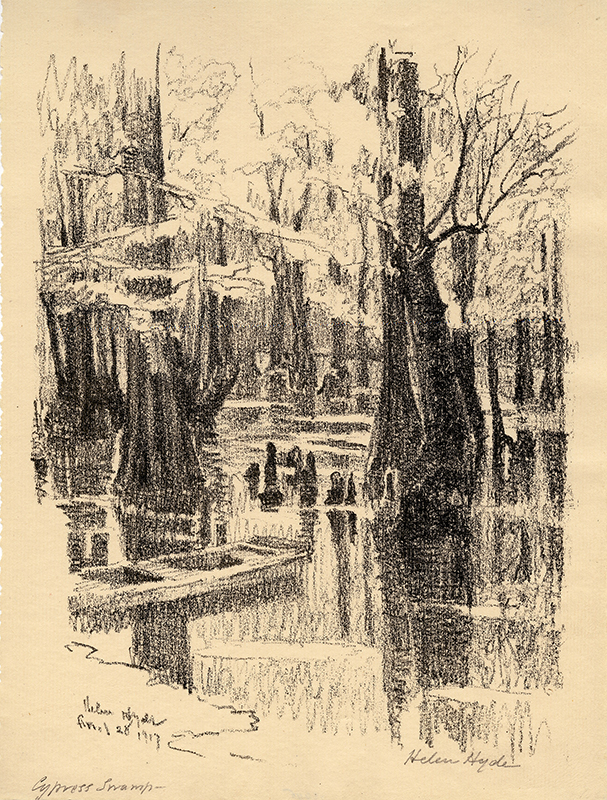Cypress Swamp is a transfer lithograph created on transfer paper in 1917 by American artist Helen Hyde. It is also known as Cypress Swamp, Belvedere, South Carolina. Hyde signed and dated her matrix April 28 1917. Cypress Swamp is pencil signed and titled. The reference is Mason 130 and an impression is illustrated on page 98 in Helen Hyde from the American Print-Makers, A Smithsonian Series. Cypress Swamp was printed on a cream laid Eturia Italy paper and the image measures 11-5/8 x 8-3/4 inches.
In 1917, Helen Hyde traveled to attend an exhibition of her woodcuts in Columbia, South Carolina and from there went to Charleston where she was stayed at Chicora Wood, the plantation owned by her friend, Elizabeth W. Allston Pringle. It was during this visit that Hyde created a series of intaglios of Black children on the plantation and a few transfer lithographs of the landscape. South Carolina is noted for its beautiful cypress swamps. These were Hyde’s last prints and the editions were never completed and impressions are quite rare.
Helen Hyde, printmaker and illustrator, was born in Lima, New York on 6 April 1868, but spent a cultured childhood in Oakland, California. At the age of twelve, Hyde began art instruction under Ferdinand Richardt but it ended abruptly two years later when her father died and her family relocated inß San Francisco. Helen and her mother moved to Philadelphia and, after her graduation from Wellesley School, she returned to San Francisco and studied at the School of Design. Hyde studied briefly with Kenyon Cox at the Art Students League in New York between 1888 and 1889. The following year she departed on a four-year sojourn in Europe, which included studying with Franz Skarbina in Berlin, Raphael Collin and Albert Sterner in Paris, and months in Holland and England.
In Paris, Hyde met Félix Régamey who introduced her to the “loveliness of things Japanese” and this meeting was to have a profound effect on her life and work. Returning to San Francisco, Hyde sought out subjects in Chinatown and produced her first series of color etchings. In 1899, she voyaged to Japan where she became an ardent student of the Japanese language and a student of classical brush painting with an Austrian artist working in Tokyo, and it was from him that she learned the skills of carving wood blocks. Hyde eventually accepted the Japanese system of divided labor and employed Japanese carvers and printers (Shohiro Murate carved her woodcuts for eleven years). Japan was Hyde's home until 1914 when she returned to the United States.
Hyde exhibited both nationally and internationally and her work won honors in Japan. She was awarded the gold medal at the Alaska-Yukon-Pacific Exhibition in Seattle in 1909 and the bronze medal for woodcut at the Panama-Pacific International Exposition in 1915. Hyde was a member of the Chicago Society of Etchers, the Printmakers Society of California, the Chicago Society of Artists and a life member of the Société de la Grauvre en Couleur.
The work of Helen Hyde is represented in the collections of the Brooklyn Museum, New York; the Glenbow Museum, Calgary, Alberta; the Art Institute of Chicago, and the Smith Museum of Art, the University of Chicago, Illinois; the University of Oregon Museum of Art, Eugene; the Indianapolis Museum of Art, Indiana; the Zimmerli Art Museum, Rutgers University, New Brunswick, New Jersey; the Metropolitan Museum of Art, and the New York Public Library, New York; the Pennsylvania Academy of the Fine Arts, Philadelphia; the Fine Arts Museums of San Francisco, California; and the Library of Congress, and the Smithsonian American Art Museum, Washington, D.C.
Helen Hyde died on 13 May 1919 in Pasadena, California.



